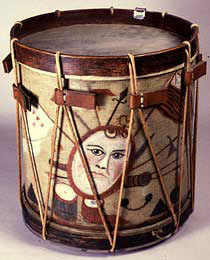|
|
|
|
|
|
|
|
 he drum and fife regulated the Revolutionary War soldier's life. By commands of music, the soldier was notified when to awake in the mornings, when to attend drill, when to stop for meals, and when to report for pay. While on the march, music assisted with cadence and order, helping men to march in time. Music encouraged soldiers to press a march or attack with vigor. he drum and fife regulated the Revolutionary War soldier's life. By commands of music, the soldier was notified when to awake in the mornings, when to attend drill, when to stop for meals, and when to report for pay. While on the march, music assisted with cadence and order, helping men to march in time. Music encouraged soldiers to press a march or attack with vigor.
 rders were also given using whistles, blowing horns, and bagpipes. Music and songs in camp lifted soldiers' spirits following exhausting duty. They helped build fellowship in the regiments. rders were also given using whistles, blowing horns, and bagpipes. Music and songs in camp lifted soldiers' spirits following exhausting duty. They helped build fellowship in the regiments.
 rums have been used to convey commands since ancient times. They provide distinct sounds that can be heard for great distances. The drum was the very voice and tongue of the commander. After the adoption of firearms, the fife came into use. Its peculiar piercing sound transcended the noise of men and gunfire, and added melody to the drumbeats. By the Revolution, armies had adopted a system of commands given by the drum and fife, which could rapidly communicate orders to whole armies at one time. rums have been used to convey commands since ancient times. They provide distinct sounds that can be heard for great distances. The drum was the very voice and tongue of the commander. After the adoption of firearms, the fife came into use. Its peculiar piercing sound transcended the noise of men and gunfire, and added melody to the drumbeats. By the Revolution, armies had adopted a system of commands given by the drum and fife, which could rapidly communicate orders to whole armies at one time.
|
|






